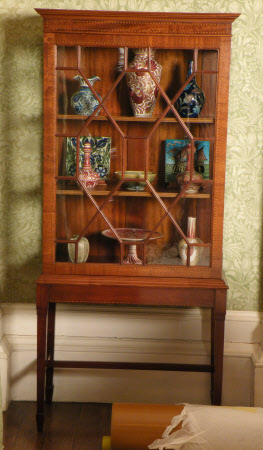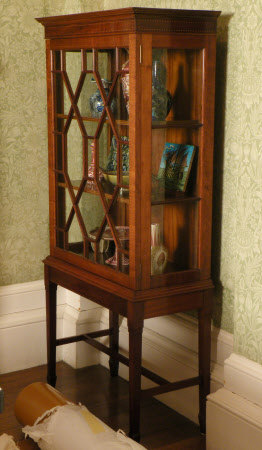Display cabinet
Morris & Co.
Category
Furniture
Date
circa 1890
Materials
Mahogany, boxwood, ebonised wood, glass
Measurements
140 x 65.5 x 33 cm
Order this imageCollection
Standen House and Garden, West Sussex
NT 1213948
Summary
A mahogany and chequer-strung display cabinet, by Morris & Co., circa 1890. Designed by George Jack in the Georgian style, with moulded cornice and fitted shelves enclosed by an astragal-glazed door, on stand with plain frieze and square tapering legs joined by stretchers and terminating in spade feet.
Full description
George Jack (1855-1931), architect and designer, designed furniture for Morris & Co. from 1885, after working in the offices of Philip Webb. Founded in 1861 as Morris, Marshall, Faulkner & Co., the firm was soon referred to as Morris & Co., although the name was not officially adopted until 1875 when William Morris (1834-1896) became sole proprietor. Responsibility for the design of almost all commissioned furniture passed to Philip Webb, whose influence was enormous, and (from 1880) his assistant George Jack, while Morris produced designs for glass, tapestries and any painted furniture. From 1871 wallpapers, designed by Morris, became an important part of the business. Show rooms in Oxford Street were acquired in 1877. Greater commercial success in the 1880s led to the opening of a shop in Manchester in 1883. Some of the well-known interior schemes undertaken by Morris include Rounton Grange in Yorkshire, Old Swan House in Chelsea, Great Tangley Manor in Surrey, Wightwick Manor, Stanmore Hall in Middlesex and Standen. In 1887, Morris & Co purchased the Holland & Sons cabinet-making workshop in Pimlico, thereby overnight acquiring one of the most skilled teams of craftsmen available.
Makers and roles
Morris & Co., manufacturer George Washington Jack (1855-1932), designer

